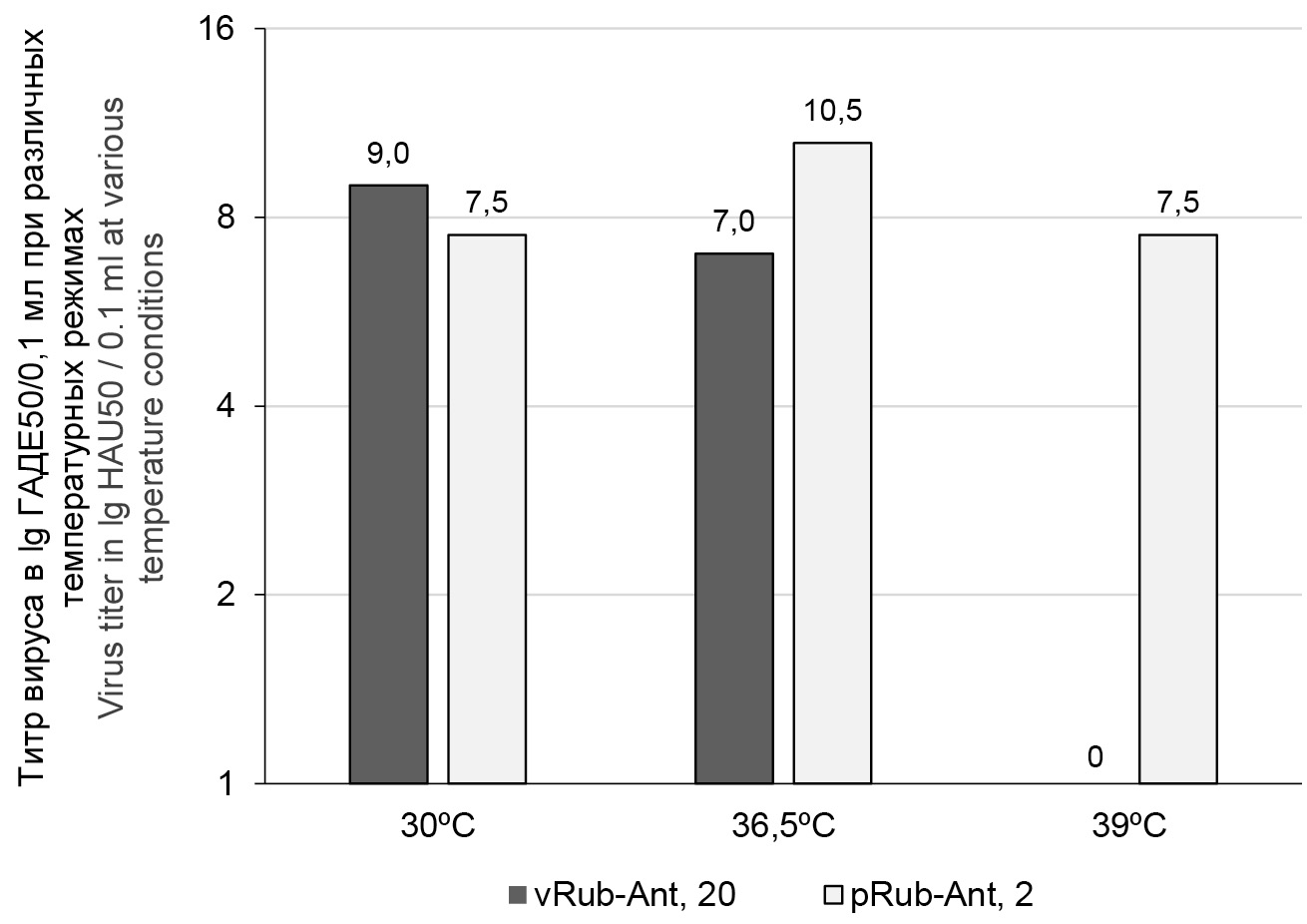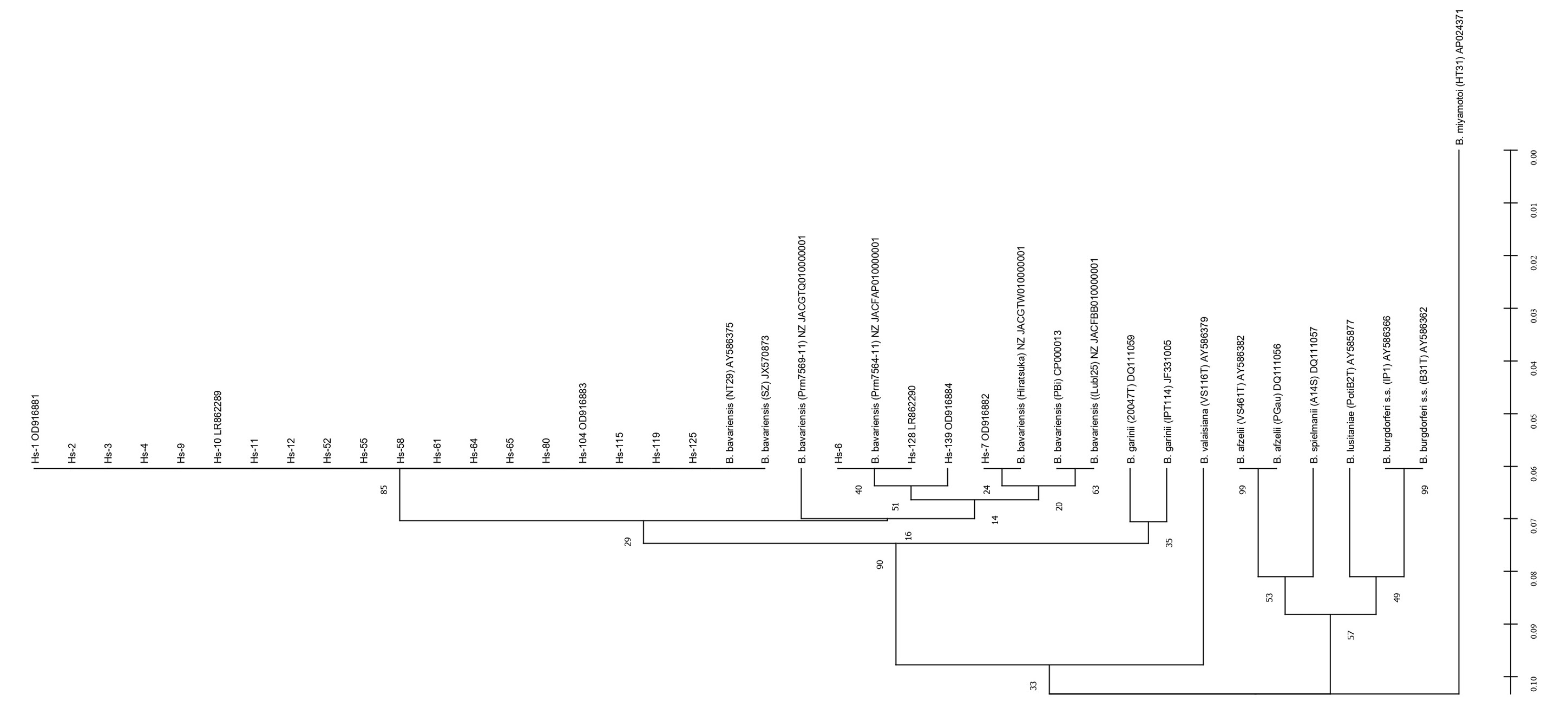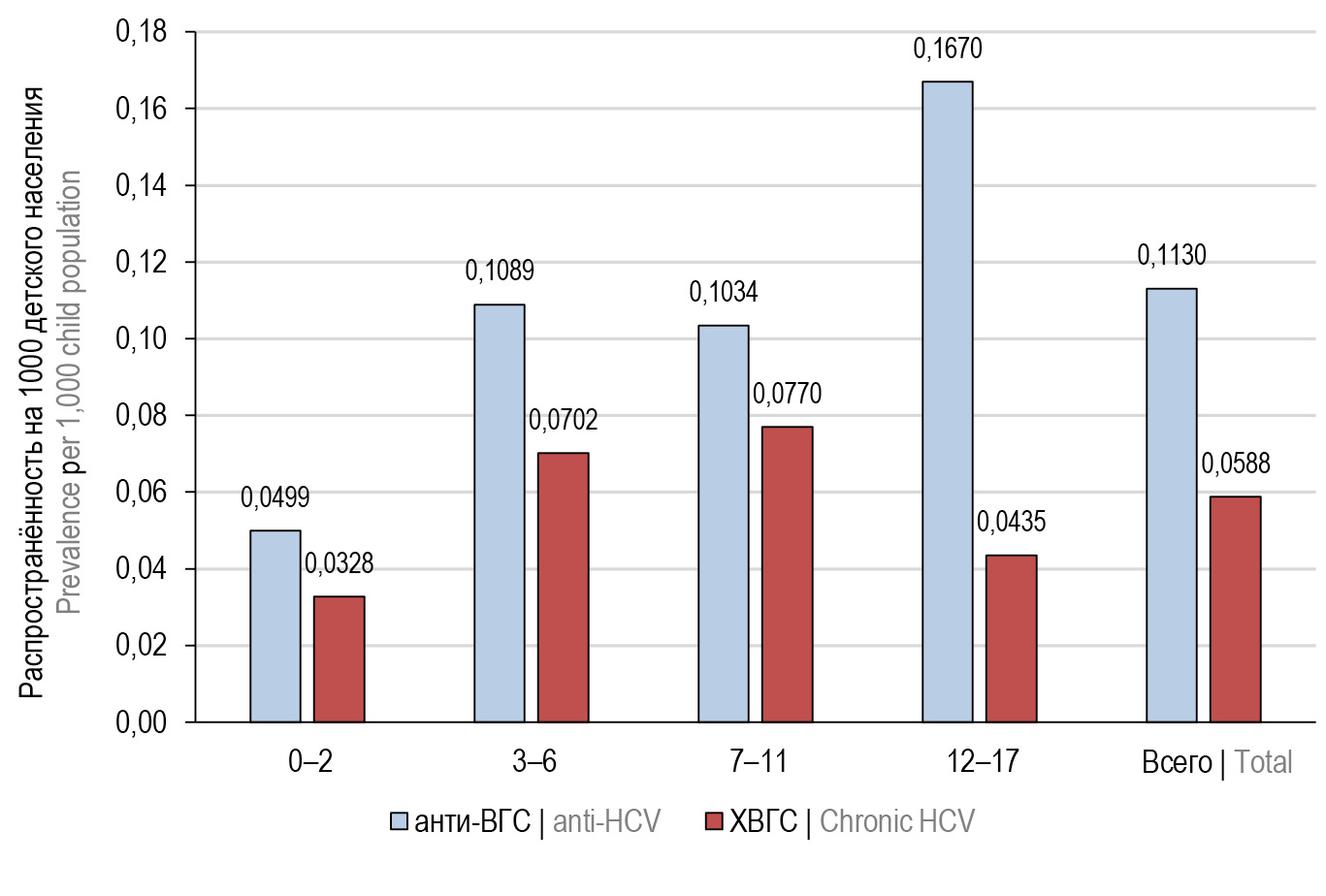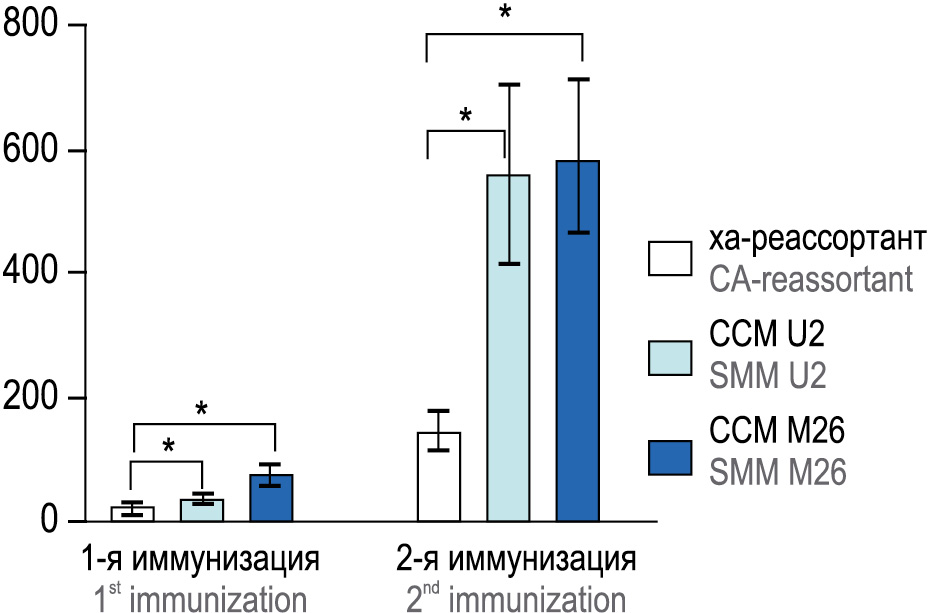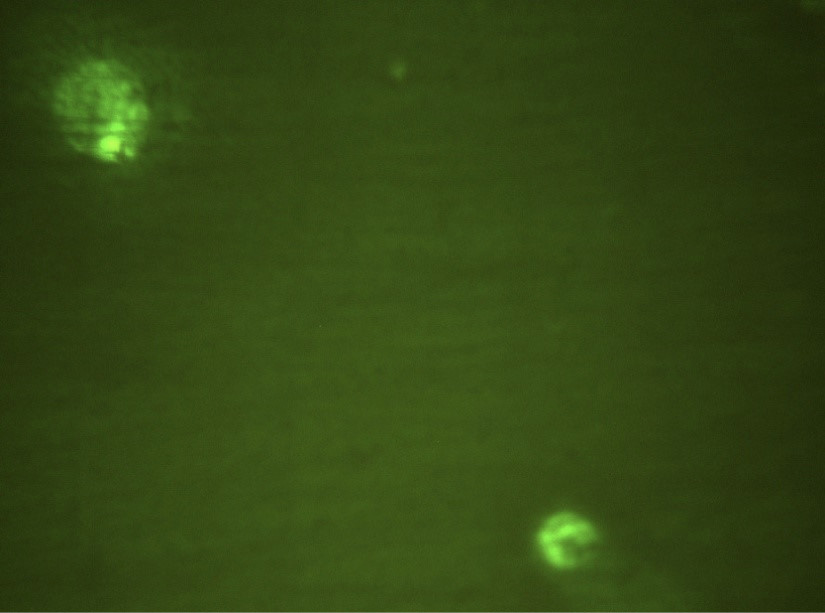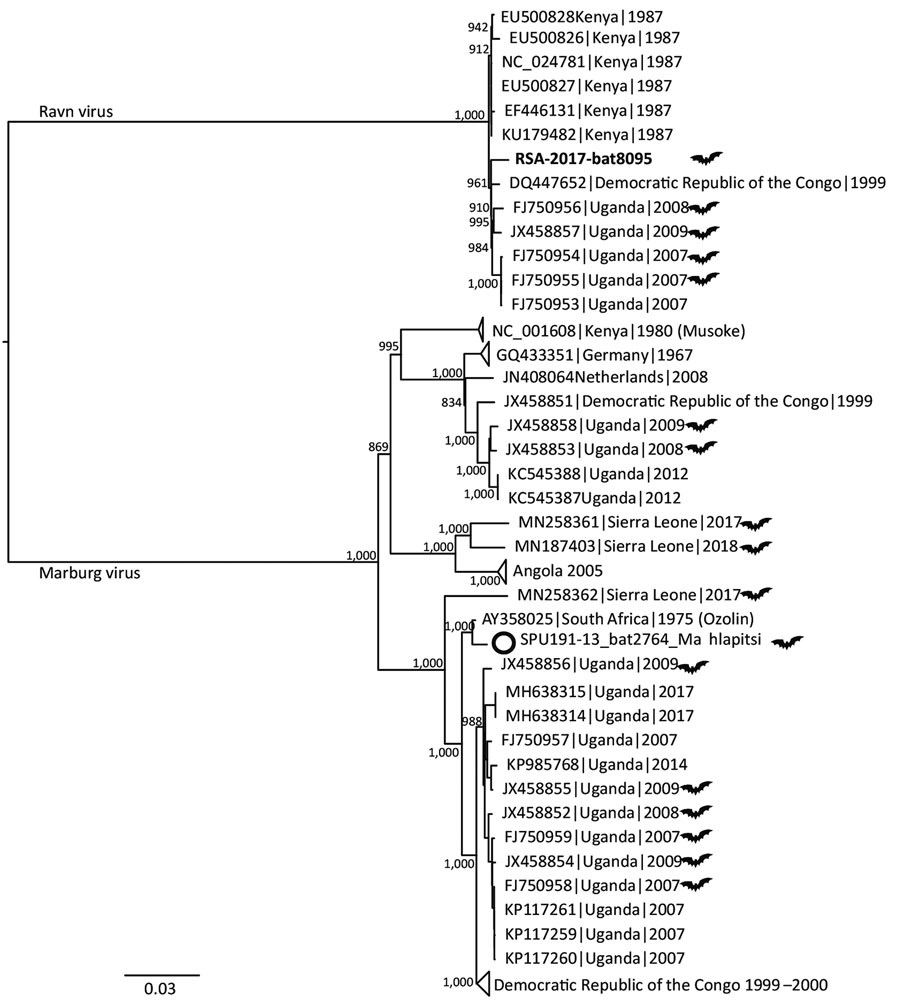Том 99, № 5 (2022)
- Год: 2022
- Дата публикации: 07.12.2022
- Статей: 11
- URL: https://microbiol.crie.ru/jour/issue/view/52
Весь выпуск
ОРИГИНАЛЬНЫЕ ИССЛЕДОВАНИЯ
Биологические свойства отечественного штамма vRub-Ant вируса краснухи
Аннотация
Введение. Краснуха — лёгкое инфекционное заболевание, поражающее преимущественно детей, вызывается вирусом краснухи (Rubella virus — RV), входящим в семейство Matonoviridae, род Rubivirus. Краснуха вызывает синдром врождённой краснухи (СВК) и является основной причиной аномалий развития, особенно слепоты и глухоты. Специфического лечения краснухи и СВК не существует. С целью избежать возможных осложнений от краснушной инфекции используется живая аттенуированная вакцина против краснухи на основе зарубежного штамма Wistar RA 27/3 RV. Однако актуальным, более эффективным и предпочтительным вакцинным штаммом RV для России считается вирусный штамм краснухи, циркулирующий на её территории.
Целью исследования являлось изучение биологических свойств созданного отечественного холодоадаптированного штамма vRub-Ant, циркулирующего на территории России.
Материалы и методы. Использовали клеточные культуры — штамм диплоидных клеток лёгких эмбриона человека ЛЭЧ-3, перевиваемую клеточную линию Vero CCL-81 и Vero ECC из эмбриональных клеток почек зелёных мартышек, мезенхимальные стволовые клетки человека, мононуклеарные клетки периферической крови человека (МКПК). Клеточные культуры выращивали на питательной среде DMEM/F 12 с добавлением 5% эмбриональной телячьей сыворотки. В качестве клинического вирусного материала использовали мазки из зева и носовых ходов от ребёнка, больного краснухой. Для оценки уровня экспрессии α/β- и γ-интерфероновых рецепторов (ИФН-Р) использовали моноклональные антиидиотипические антитела, имитирующие биологические эффекты α/β- и γ-ИФН человека. В работе применяли культуральные, вирусологические, иммунохимические и серологические методы исследования.
Результаты. Аттенуацию клинического изолята рRub-Ant RV проводили на протяжении 20 последовательных пассажей на диплоидных клетках ЛЭЧ-3 при пониженной температуре 30°С. Определены основные биологические маркеры аттенуации: температурочувствительность и холодоадаптированность. Установлен более низкий уровень экспрессии α/β- и γ-ИФН-Р на мембранах МКПК человека, индуцированных вакцинным штаммом vRub-Ant в сравнении с родительским диким вариантом RV. Этот признак характерен для аттенуированных вирусных штаммов. Показано, что вакцинный штамм vRub-Ant утратил нейротропизм и не связывается с мембранными рецепторами мозга эмбрионов морских свинок, в отличие от дикого родительского варианта RV. Высокая иммуногенность отечественного холодоадаптированного штамма vRub-Ant подтверждается высокими титрами нейтрализующих краснушных антител у морских свинок, привитых подкожно одной прививочной дозой вируса.
Заключение. Создан отечественный аттенуированный вакцинный штамм vRub-Ant RV, обладающий основными биологическими маркерами аттенуации. Вакцинный штамм vRub-Ant вызывает высокий уровень нейтрализующих антител в организме морских свинок при однократной иммунизации одной прививочной дозой вакцины. Вирусный штамм vRub-Ant утратил тропизм к мембранным рецепторам мозга эмбрионов морских свинок, в отличие от своего родительского варианта.
 505-513
505-513


Оптимизация мультилокусного сиквенс-анализа для лабораторной идентификации возбудителей иксодового клещевого боррелиоза
Аннотация
Введение. Наиболее широко распространённые этиологические агенты иксодового клещевого боррелиоза (ИКБ) в России — Borrelia garinii, B. afzelii, B. bavariensis. Для определения видовой принадлежности боррелий в современных исследованиях используют методы мультилокусного сиквенс-типирования и сиквенс-анализа (МЛСА). Ранее были продемонстрированы результаты применения схемы МЛСА для идентификации возбудителей эритемных форм ИКБ.
Цель работы — изучить возможность оптимизации МЛСА для практической лабораторной идентификации возбудителей ИКБ. Задачи: сравнительный анализ нуклеотидных последовательностей локусов 6 консервативных генов (rrs, hbb, fla, groEL, recA, ospA) и межгенного спейсера rrfA-rrlB, рекомендованных протоколом МЛСА; выявление минимальной совокупности генов, сцепленные сиквенсы которых позволяют идентифицировать видовую принадлежность изолята боррелий.
Материалы и методы. Сиквенсы вышепредставленных локусов 23 «контрольных» изолятов, полученных от больных ИКБ и предварительно типированных методом МЛСА как B. bavariensis, использованы для сравнительного анализа с последовательностями аналогичных генов других видов боррелий, имеющимися в международных базах данных. На основе этого материала методом UPGMA построена и проанализирована серия дендрограмм.
Результаты. Сиквенсы локусов гена ospA контрольного вида показали наибольшее отличие (не менее 8,5%) от последовательностей этого гена у других сравниваемых видов боррелий; близкие показатели видовых отличий (не менее 6,7%) продемонстрировало сравнение сиквенсов гена recA. Сиквенсы выявленных вариантов двух этих генов у B. bavariensis отличались от последовательностей аналогичных генов у наиболее близкого вида — B. garinii. Дендрограмма сцепленных нуклеотидных последовательностей генов recA и ospA продемонстрировала её идентичность результатам идентификации изолятов по полному протоколу МЛСА.
Заключение. Предложен оптимизированный подход к МЛСА боррелий группы B. burgdorferi sensu lato, который сводится к выявлению их видовой принадлежности на основании специфики результата сцепленного анализа локусов только двух генов (recA и ospA) из 7 локусов, рекомендованных протоколом этого метода.
 514-524
514-524


Каскад медицинской помощи детям с инфекцией, вызванной вирусом гепатита С, в Московской области
Аннотация
Актуальность. Детям и подросткам с инфекцией, вызванной вирусом гепатита С (ВГС), уделялось недостаточно внимания из-за более лёгкого течения и отставания одобрения схем противовирусной терапии. Следует устранить пробелы исследований в педиатрических когортах и недостатки политики ведения детей, обеспечив организацию доступа к тестированию и лечению.
Цель исследования — представить результаты каскадной последовательности мер оказания медицинской помощи детям с ВГС в Московской области (МО).
Материалы и методы. Включены все серопозитивные к ВГС дети МО (n = 175), прошедшие скрининговое тестирование, и не включены пациенты, живущие с коинфекцией ВИЧ/ВГС. Дети наблюдались в 2017–2022 гг. РНК ВГС определена у 164 и его генотипирование — у 99. Стадия фиброза печени оценена у 73 детей с помощью транзиторной эластографии и расчёта индекса FIB-4.
Результаты. В МО охват тестированием на РНК ВГС-серопозитивных детей составил 93,7%, пролечено 71,2% подростков старше 12 лет. Распространённость серопозитивности к ВГС оценивается как не менее 0,113/1000 детского населения, хронической ВГС-инфекции — как не менее 0,059/1000. Доминировали субтипы G1b (43,4% [95% доверительный интервал 33,5–53,8%]), G3a (23,2% [15,3–32,8%]) и G3a/3b (20,2% [12,8–29,5%]). Заболеваемость виремической ВГС на 100 тыс. детей составила 3,3 у детей младше 3 лет; 7,0 — у детей 3–6 лет; 7,7 — у детей 7–11 лет, 4,4 — у подростков старше 12 лет. Естественный клиренс ВГС зарегистрирован с частотой 19,5% [13,8–26,4%]. Внепечёночные проявления встречались редко — 2,9% [0,9–6,5%]. Основной путь передачи ВГС — вертикальный (78,3% [71,4–84,2%]), предполагаемое заражение при медицинских инвазивных процедурах — 7,4% [4,0–12,4%], употреблении наркотиков — 0,6% [0,01–3,10%], в семейном очаге — 0,6% [0,01–3,10%]. Новые случаи ВГС-инфекции выявлялись чаще при плановом обследовании детей перед госпитализацией или у рождённых от матерей с ВГС. Виремическая ВГС подтверждена у 90,2% [84,6–94,3%], в том числе ВГС-инфекция — у 53,4% [45,0–61,6%], хроническая болезнь печени — у 35,8% [28,1–44,1%] с низкой степенью активности и редкими последствиями (фиброз по шкале METAVIR F1 и F1-2 — 17,8% [9,8–28,5%]). Не установлено существенных клинико-эпидемиологических отличий между естественным течением хронической ВГС-инфекции и болезни печени, вызванной ВГС. Бремя педиатрической ВГС в МО утяжелено значительной долей социально уязвимых и коморбидных пациентов.
Заключение. Резервом для выявления новых случаев ВГС-инфекции в МО у детей может быть укрепление преемственности между медицинскими организациями и раннее лечение женщин детородного возраста. Необходимы исследования, чтобы оценить эффективность рутинного тестирования всех социально уязвимых педиатрических групп. Раннее применение пангенотипных схем противовирусной терапии, вероятно, быстро позволяет контролировать заболеваемость ВГС-инфекцией у детей.
 525-539
525-539


Компетентность комаров Culex pipiens f. molestus как переносчиков вируса Западного Нила при различных температурных условиях
Аннотация
Введение. Комары Culex pipiens являются одним из компетентных видов переносчиков вируса Западного Нила (ВЗН). Culex pipiens f. molestus (Cх. р. f. molestus) — синантропная, автогенная, широко распространённая форма вида, способная питаться на широком круге хозяев, в том числе на человеке. Температура среды обитания насекомых влияет на потенциал вирусофорности, чем определяет их компетентность как переносчиков возбудителя лихорадки Западного Нила (ЛЗН).
Цель — экспериментальное изучение влияния температуры среды обитания личинок на компетентность комаров Cх. p. f. molestus как переносчиков ВЗН.
Материалы и методы. В работе использовали штамм ВЗН (WNV_Volg601/18 2 генотипа) и лабораторную культуру комаров Cх. p. f. molestus. Концентрацию вирусного изолята определяли методом бляшкообразования с помощью культуры клеток Vero. Заражение насекомых проводили перорально на личиночной стадии с последующей инкубацией на протяжении всего цикла при 20, 22 или 28ºC. Через 72 ч после вылета всех имаго из куколок комаров обездвиживали на холоде, определяли пол, выделяли у самок слюнные железы, исследовали их на наличие ВЗН и определяли его титр.
Результаты. В результате исследования установлено, что ВЗН в титре, достаточном для передачи патогена при кровососании, был обнаружен в слюнных железах насекомых, развивающихся при температуре 22 и 28ºC, при этом его концентрация повышалась с увеличением температуры среды. В слюнных железах самок насекомых, развивающихся при температуре 20ºC, вирус не выявлен.
Заключение. Температура среды обитания является одним из ключевых факторов, ограничивающих репликацию и концентрацию ВЗН в слюнных железах комаров Cх. p. f. molestus.
 540-544
540-544


Влияние трипсина, лидазы и флуимуцила на рост биоплёнок Bordetella pertussis на абиотическом субстрате
Аннотация
Цель работы — изучение влияния трипсина, лидазы (гиалуронидазы) и флуимуцила (N-ацетил-L-цистеин) на рост биоплёнок штаммов Bordetella pertussis на абиотическом субстрате.
Материалы и методы. В опытах использовали выделенные в России от больных коклюшем в 2001–2010 гг. штаммы основных сероваров B. pertussis: № 178 (серовар 1.2.0), № 287 (серовар 1.0.3) и № 317 (серовар 1.2.3), выращенных на плотной питательной среде. Интенсивность образования биоплёнок в жидкой питательной среде в присутствии трипсина, лидазы и флуимуцила в круглодонных полистироловых 96-луночных планшетах оценивали при окрашивании 0,1% раствором генциан-фиолетового.
Результаты. Трипсин подавлял рост биоплёнок и разрушал сформированные биоплёнки. Лидаза менее активно подавляла рост биоплёнок, не оказывая влияния на сформированные биоплёнки. Флуимуцил не влиял как на рост биоплёнок, так и на сформированные биоплёнки. При посеве надосадочных жидкостей из культур в присутствии препаратов, а также из лунок контроля культуры на плотную питательную среду был отмечен рост типичных для B. pertussis колоний.
Заключение. Различный эффект исследованных нами препаратов может быть связан с различным количественным содержанием мишеней для трипсина (протеины), лидазы (мукополисахариды, содержащие уроновые кислоты), флуимуцила (кислые мукополисахариды) в составе матрикса биоплёнок. Рост типичных по морфологическим свойствам колоний В. pertussis при посеве надосадков культур на плотную питательную среду свидетельствует о разрушении матрикса биоплёнок трипсином и лидазой при отсутствии влияния на планктонные клетки.
 545-551
545-551


Модифицированая питательная среда для выделения и идентификации неферментирующих бактерий
Аннотация
Введение. Актуальность данного исследования обусловлена необходимостью лабораторного мониторинга за циркуляцией неферментирующих грамотрицательных бактерий (НГОБ), имеющих высокую этиологическую значимость в возникновении инфекций, связанных с оказанием медицинской помощи, а также трудоёмкостью дифференциации данных бактерий на простых питательных средах от представителей энтеробактерий и отдельных представителей НГОБ.
Целью данного исследования явилось конструирование дифференциально-диагностической среды, содержащей отечественные ингредиенты.
Материалы и методы. Определяли эффективность роста тест-штаммов на сопоставляемых питательных средах, их культуральные и морфологические признаки.
Результаты. Предлагаемая модифицированная питательная среда позволяет по цвету колоний и характеру роста как отличать тест-штаммы НГОБ от тест-штаммов других бактерий (грамотрицательных энтеробактерий, стафилококков), так и различать их между собой, что даёт возможность применять предлагаемую модифицированную питательную среду для дифференциации неферментирующих бактерий от ферментирующих и одновременно первичной дифференциации разных представителей неферментирующих бактерий по изменению цвета среды и цвету колоний.
 552-556
552-556


Сравнительное изучение биологических свойств мутантов вируса гриппа А, полученных с помощью сайт-специфического мутагенеза, и варианта живой гриппозной реассортантной вакцины
Аннотация
Цель исследования — сравнительное изучение биологических свойств сайт-специфических мутантов вируса гриппа А и гриппозной реассортантной вакцины.
Материалы и методы. Для изучения генетической стабильности сайт-специфических мутантов штамма А/WSN/33 вируса гриппа А была использована методика температурного стресс-теста, который проводили в культуре клеток Madin–Darby Canine Kidney (MDCK). Иммуногенность изучали путём интраназальной иммунизации мышей исследуемыми вирусами. Титр антител определяли с помощью реакции торможения гемагглютинации и иммуноферментного анализа. Способность вирусов индуцировать интерферон 1-го типа в клетках A549 выявляли методом полимеразной цепной реакции в реальном времени.
Результаты. Исследована генетическая стабильность сайт-специфических мутантов штамма А/WSN/33 (H1N1) с разным количеством чувствительных к температуре (temperature-sensitive — ts) мутаций в генах, кодирующих белки полимеразного комплекса, при помощи стресс-теста в культуре клеток MDCK. Показано, что мутанты U2 и M26, имеющие, соответственно, 3 и 5 ts-мутаций в генах, кодирующих полимеразные белки, обладают высокой генетической стабильностью. Проведено сравнительное изучение способности мутантов U2 и M26, а также холодоадаптированного (ха) реассортанта индуцировать гуморальный иммунитет при интраназальной иммунизации мышей. Обнаружено, что мутанты способствуют более высокой выработке сывороточных антител, чем ха-реассортант. Изучена способность мутантов U2 и M26, а также ха-реассортанта индуцировать экспрессию интерферонов 1-го типа (α-1, α-2, α-4 и интерферон-β) в культуре клеток А549. Показано, что мутанты в большей степени повышают уровень интерферонов 1-го типа по сравнению с ха-реассортантом.
Заключение. Сайт-специфические мутанты вируса гриппа А, имеющие в полимеразных генах 3 и 5 ts-мутаций, показывают высокий уровень генетической стабильности. Они обладают высокой иммуногенностью и индуцируют более высокий уровень интерферона 1-го типа по сравнению с ха-реассортантом. Это позволяет рассматривать сайт-специфические мутанты U2 и M26 в качестве кандидатов в живые гриппозные вакцины.
 557-564
557-564


Диагностическое значение рецепторов TLR2 и TLR4 на лимфоидных клетках как маркера прогрессирования воспаления пародонта, ассоциированного с ключевыми пародонтопатогенными видами F. alocis и P. gingivalis
Аннотация
Цель работы — оценка диагностического значения экспрессии TLR2 и TLR4 на лимфоидных клетках пародонта и периферической крови методом иммунофлюоресцентной микроскопии у больных хроническим пародонтитом (ХП), ассоциированным с ключевыми пародонтопатогенными видами Filifactor alocis и Porphyromonas gingivalis.
Материалы и методы. В исследование были включены 150 пациентов — 88 (59%) женщин и 62 (41%) мужчины в возрасте 18–73 лет с ХП в фазе обострения и 32 человека без признаков ХП. Для подтверждения диагноза пародонтита использовали набор для полимеразной цепной реакции (ПЦР) «МультиДент-5» (выявление P. gingivalis, Prevotella intermedia, Tannerella forsythia, Treponema denticola, Aggregatibacter actinomycetemcomitans), а также rt-PCR — для F. alocis и P. gingivalis в содержимом пародонтального кармана. Для оценки клеток, несущих маркеры CD282 и СD284, использовали смывы десневой жидкости из пародонтального кармана раствором Хенкса. Выделенные клетки окрашивали антителами к маркерам CD282 (соответствует рецептору TLR2) или СD284 (соответствует рецептору TLR4), меченными изотиоцианатом флуоресцеина, и фиксировали параформальдегидом для последующей иммунофлюоресцентной микроскопии.
Результаты. Изучена экспрессия TLR2 и TLR4 на лейкоцитах периферической крови и десневой жидкости у людей со здоровым пародонтом и больных ХП, ассоциированным с F. alocis и P. gingivalis. По результатам ПЦР частота выявления F. alocis и P. gingivalis составила 64 и 62,7% соответственно, что подтверждало их доминирование в микробной ассоциации. Установлено, что экспрессия TLR2 и TLR4 на лимфоидных клетках периферической крови у людей варьировала. Обсуждается возможное диагностическое значение этого феномена при оценке прогрессирования ХП.
Заключение. У больных ХП, ассоциированным с доминированием пародонтопатогенных видов F. alocis и P. gingivalis, выявлена разнонаправленная экспрессия TLR2 и TLR4 на клетках периферической крови, которая может иметь диагностическое значение при оценке прогрессирования заболеваний пародонта.
 565-572
565-572


ОБЗОРЫ
К вопросу об актуальности разработки и перспективам использования препарата бактериофага Streptococcus pneumoniae
Аннотация
Введение. Распространённость штаммов Streptococcus pneumoniae, вызывающих инвазивные формы пневмококковой инфекции, и растущие показатели антибиотикорезистентности отдельных серотипов возбудителя ставят в ряд актуальных и социально значимых задач поиск новых антимикробных средств для профилактики и лечения.
Цель — провести поиск научных публикаций отечественных и зарубежных авторов о проблемах практического использования и перспективах разработки препарата бактериофага S. pneumoniae узконаправленного действия на актуальные серотипы возбудителя.
Результаты. Анализ литературных источников в научных электронных базах и издательствах eLibrary.Ru, ScienceDirect, Scopus, PubMed, Springerlink, Wiley Online Library, Annual reviews позволил обобщить сведения о 4 выделенных литических бактериофагах S. pneumoniae и их эндолизинах, а также 2 умеренных фагах, представить данные клинической эффективности стрептококкового бактериофага при пневмококковой инфекции у животных и человека. Результаты поисковых запросов о наиболее значимых и распространённых на территории России серотипах S. pneumoniae установили преобладание в структуре вариантов 19F, 14, 9V/A, 15 A/F, 6 A/B/C/D, 3 и 23F. Часть из них характеризуется высоким уровнем антибиотикорезистентности и вызывает тяжёлые формы заболевания, при этом серотипы 15 A/F/C и 6 C/D не представлены в составе современных вакцинных штаммов, что повышает актуальность разработки и использования пневмококкового бактериофага, в том числе для внутривидового типирования значимых и распространённых серотипов.
Заключение. На основании анализа современного состояния вопроса о пневмококковых бактериофагах, полученных сведений о циркуляции актуальных штаммов S. pneumoniae на территории России и их серотиповом пейзаже сделан вывод об актуальности разработки препарата бактериофага S. pneumoniae как средства направленного действия для профилактики, диагностики и персонализированной терапии заболеваний человека пневмококковой этиологии.
 573-586
573-586


Вирус Марбург и вызываемое им заболевание
Аннотация
За 50 лет с момента открытия изучены многие свойства вируса Марбург, но надёжных медицинских средств профилактики и лечения вызываемой им инфекции не разработано, хотя он потенциально может вызвать крупномасштабные эпидемии.
Лихорадка Марбург актуальна в связи с риском заноса в другие страны. Источник инфекции в природе — летучие мыши (резервуар) и обезьяны (промежуточный хозяин), а пути передачи — аэрозольный, контактный и алиментарный. Уровень летальности в последних вспышках достигал 90%. Возбудитель выявляли у реконвалесцентов в слезах, сперме и биопсийных материалах печени через недели и месяцы после выздоровления.
Отсутствие лечебно-профилактических противовирусных препаратов, высокие показатели летальности, инфекциозности, способность аэрозольного заражения, высокий эпидемический потенциал в совокупности определяют лихорадку Марбург как серьёзную глобальную угрозу международному здравоохранению. Разработка средств медицинской защиты от данной инфекции должна быть насущной задачей обеспечения биологической безопасности населения России.
Наиболее перспективные пути разработки вакцин против лихорадки Марбург — конструирование рекомбинантов на основе аденовируса, вируса везикулярного стоматита или альфавирусного репликона, ДНК-вакцины. Показано достоверное защитное действие химиопрепарата ремдесивир в сочетании с человеческими антителами, а также этиотропного препарата с антисмысловым механизмом действия и индуктора интерферона. В модельных опытах с псевдовирусом найдены принципиально новые пути разработки ингибиторов возбудителя — препятствие выходу его из клеток, а также конструирование антигенсвязывающих Fab-фрагментов, ингибирующих синтез вирусной РНК.
 605-618
605-618


Анатомо-физиологические аспекты патогенеза ВИЧ-инфекции у животных моделей
Аннотация
Понимание всего патогенеза ВИЧ-инфекции — от проникновения инфекции до индукции тяжёлого иммунодефицита — важно для разработки новых методов лечения. Неполные 40 лет исследований механизмов ВИЧ-инфекции, приводящих к развитию синдрома приобретённого иммунодефицита (СПИДа), собрали колоссальное количество информации, однако собственная уникальная изменчивость ВИЧ выявляет все новые пробелы.
Несмотря на постоянное усовершенствование протоколов антиретровирусной терапии и успехи её применения, остановить распространение ВИЧ-инфекции пока не удаётся. Развитие новых протоколов и испытание новых групп антиретровирусных препаратов возможно, в первую очередь, благодаря совершенствованию животных моделей патогенеза ВИЧ-инфекции. Их релевантность, несомненно, повышается, но в то же время зависит от конкретных исследовательских задач, т.к. ни одна из моделей in vivo не может всесторонне имитировать механизм инфекционной патологии человека, приводящей к мультиорганному поражению.
Цель работы — представить актуальную информацию по известным животным моделям ВИЧ-инфекции, акцентируя внимание на способе их инфицирования и анатомо-физиологических и патологических особенностях.
 587-604
587-604










